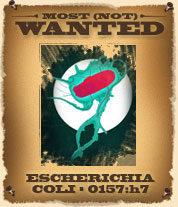
Photo: © Dr. Linda Stannard
UCT / SCIENCE PHOTO LIBRARY
Name
Escherichia coli O157:H7
Also known as
"Hamburger Disease", E. coli
Description
- rod-shaped bacterium
- often appears in need of a shave due to tiny projecting fingers (fimbriae)
(Not) Wanted for
causing each year an estimated 780 to 900 million cases of diarrhoea and up to 500,000 deaths;
occasionally creating a life-threatening complication called hemolytic uremic syndrome (HUS), which requires hospitalization, and may leave a life-long legacy of kidney problems, blindness, and paralysis.
Modus operandi
- enters a host unnoticed, usually by hiding on food
- adheres to intestinal cells and produces a toxin that causes severe bloody diarrhoea and abdominal cramps, but usually no fever
Symptoms appear three to four days after this bacterium's arrival and usually disappear five to 10 days later.
Preferred hideouts
- the intestines of healthy cattle, sheep, goats, and deer
Preferred means of travel
- at the start, animal faeces, then most often meat, especially ground beef, but sometimes dairy products, water, or food prepared with or washed in contaminated water
Associates
- part of the large E. coli "family" of bacteria
Some forms of E. coli are not dangerous, but are normal and even beneficial residents in the human digestive tract.
Area of operation
- the entire globe
Learn about other pathogens on the Most (Not) Wanted list...
Salmonella typhi
Campylobacter jejuni
Giardia lamblia
Vibrio cholerae


